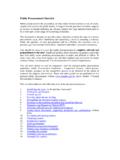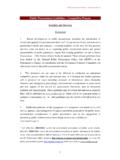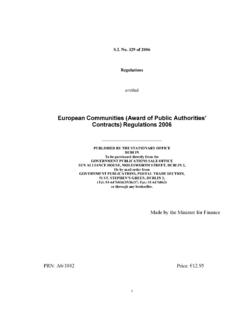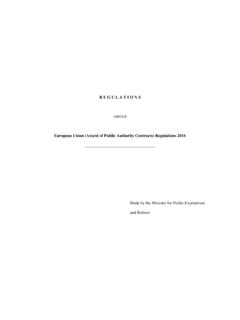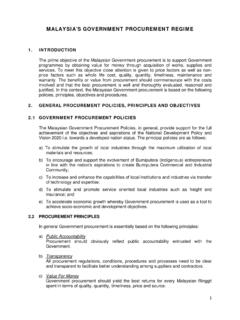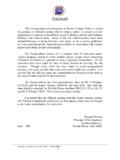Transcription of Guidance on Framework Agreements - eTenders
1 1 Guidance on FrameworkAgreements purpose of this document is to provide Guidance to public purchasers on the operation offramework Agreements as provided for under current public procurement Directivesand national regulations which implement those Directives. It outlines the procedures for establishingframeworks, types of frameworks (single supplier, multiple suppliers) and procedure for award of contracts based on frameworks. The Guidance relates to Framework arrangements being put in place by contracting authorities covered by Directive 2004/18/EC as implemented bySI 329 of 2006.
2 Tothe adoption of the currentpublic procurement Directives,2004/17/ECcovering the utilities sectorand 2004/18/ECcovering the public sector,a provisionfor Framework Agreements existed only in the utilities sector. However, public sector contracting authorities in many Member States operated efficient Framework type arrangements, based on competitive tendering,which represented good practice and achieved value for money. These typicallywere used to draw down commonlyprocured supplies or services as needs arose in a given the absence of a specific provision covering Framework , there was uncertainty as to how some ofthese arrangementscomplied withthe legalprovisions ofthe public sector procurement Directives.
3 This uncertainty is removed with the implementation ofDirective 2004/18 new public sector Directive2004/18/EC takeson board the definit io n offramework Agreements as set out in Utilities Directivesbut introduces provisions designed to ensure that theyare awarded in an open, transparent and competitive manner. Article 1(5) definesa Framework agreement as an agreement between one or more contracting authorities and one or more economic operators, the purpose of which is to establish the terms governing contracts to be awarded during a given period, in particular with regard to price and, where appropriate, the quantity.
4 In effect, Framework Agreements are Agreements with suppliers or service providers which set out terms and conditions under which specific purchases can be made duringthe termofthe 32 ofDirective 2004/18/EC sets out theconditions and procedures under which Agreements must beset up and contracts based on the Agreements awarded1. 1 Regulations 33, 34 and 35 of SI No. 329 of 2006 implementArticle 32 of Directive 2004/18/EC. These regulations are set out in an appendix to this of of frameworks arise from the flexibility they bring to the public a transparent and competitive mechanism whereby contracting authorities can place contracts with suppliers in the Framework without having to carryout oneroustendering procedures for individual requirements that are covered by the Framework reduced administrative cost of tendering either within or across contracting authorities potentialto develop competition on price and or quality and ensure better service
5 Potentialto encourage competit ion, in particular wherethere are limited numbers of suppliers, withresulting costbenefit and improved serviceto contracting authorities. However these advantages can only be achieved where public purchasershavean understanding of the market in which they are operating,and how competit ive pressures work in that market,toenable themestablish the appropriate conditions for the Framework to operate. contracting authorityalsoneeds to be in a position to manage the Framework in particular if the Framework is for technical, complexor high value goods or services or operates across a number of authorities.
6 In such cases, the needs ofthe suppliers and the relevant purchasersneed to be met, in regard to customer complaints, supplier complaints, monitoring of the Framework so that it is operated in accordance with the terms set down and is delivering required outcomes. Such frameworks may need dedicated contract management. Smaller frameworks within contracting authoritiescan generallybe managed internally. may not always be a suitable purchasing/procurement strategy and contracting authoritiesneed to assesswhether or not theyare suitable for the acquisition of particular goods or services.
7 For example, a Framework arrangement might not be the most suitable for long term service contracts that typically might run lo nger than the duration of a Framework agreement (normalmaximum 4 years, see ). general, where Framework Agreements are put in place,theyshouldprovide an economic and efficient means ofpurchasing and supply. Their use shouldbe generally advantageous and more beneficial to authorities than carrying out standard tendering procedure for individual requirements. It would be expected, therefore, that theywould be generally usedby the participating authority or authoritiesfor works, 3supplies or serviceswhich are the subject of a Framework agreement .
8 However, purchasing outside the Framework is not precluded where, for instance, an authority believes that the terms of the Framework do not fit a particular requirement or that more advantageous terms can be obtained outside the Framework . authorities and scope for use be set up by -individual contracting authorities-a contracting authority acting on behalf of a number of other contracting authorities-a central purchasing authority acting on behalf of a sector or group of contracting authoritiesWhen a Framework is being establishedon behalf of a group of contracting authorities or a central purchasing authority, the authorities which are party to it must be made clear.
9 This can be done either by listing the authorities in the notice or Framework documentation or describing them in a way that makes the scope and range of the Framework clear to marketoperators. For instance it would probably be acceptable to describe a Framework as applying to all central Government Departments and Offices or all Local Authorities in the province of XXX in the published notice, and for greater clarity,listing the relevant authorities in the Framework documentation. On the other hand, for example, describing a Framework as open to all public bodies would not be sufficiently clear and transparent.
10 Some key features of frameworks Agreements :-can be placed byanindividual contracting authority, a group of contracting authorities or a central purchasing authority-can be with a single supplier or multiple suppliers-if with multiple suppliers, the minimum number must be three (provided there are at least this number of qualified candidates)- mini competitions may be held between participants as needs arise-the maximum duration is four years (unless in exceptional circumstances justified by the subject of the Framework )-the terms and criteria for awarding contracts must be published at outset and not substantially theuse of a Framework tocontracting authoritiesnot included at the outsetis specifically precluded.

